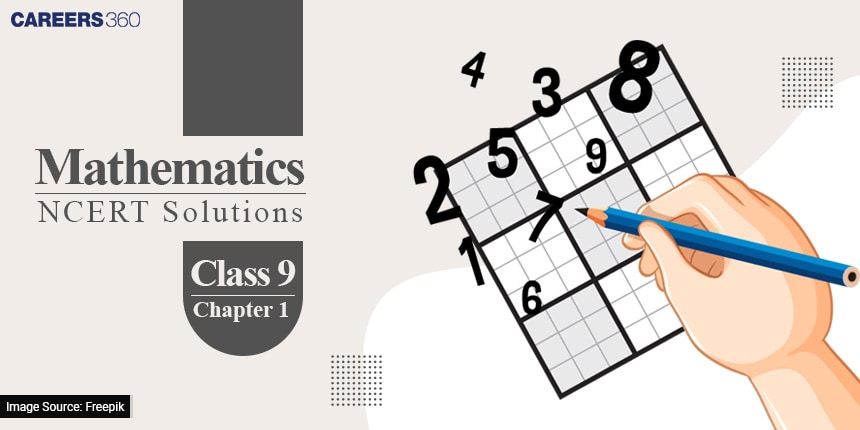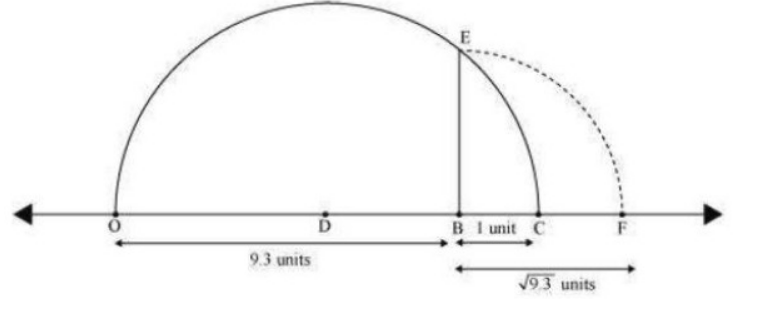Aakash Repeater Courses
ApplyTake Aakash iACST and get instant scholarship on coaching programs.
Imagine you return from the grocery store and see that you forgot to buy 3 out of 10 things your mother asked you to buy. Or, during the calculation of your savings at the end of the month, wondering if the spending is greater than your pocket money. Or checking the current temperature on your phone. These are all examples of various forms of numbers like fractions, negative, positive, etc., and in Class 9 Maths NCERT chapter 1, students will get to know more about the number systems. In this chapter, we will study rational and irrational numbers, real numbers and the operations and laws of exponents of real numbers. The NCERT Solutions for Class 9 Maths provide a clear understanding of real numbers, helping in concept clarity and exam preparation.
Don't Miss: Best Courses after 10th | Competitive Exams after 10th

Numbers are everywhere, and without them, our daily lives are incomplete. NCERT Solutions for Class 9 are prepared by the experienced Careers360 experts, and the latest CBSE syllabus has been followed in these solutions. Also, by referring to these solutions, students can practice various methods to convert decimals and apply exponents effectively. The solutions for other subjects and classes can be downloaded from the NCERT Solutions.
|
Class 9 Maths Chapter 1 Question Answer: Exercise: 1.1
Total Questions: 4
Page number: 5
|
Question 1: Is zero a rational number? Can you write it in the form
Answer:
Any number that can represent in the form of
Now, we can write 0 in the form of
for eg.
Therefore, 0 is a rational number.
Question 2: Find six rational numbers between 3 and 4.
Answer:
There is an infinite number of rational numbers between 3 and 4. One way to take them is
Therefore, six rational numbers between 3 and 4 are
Question 3: Find five rational numbers between
Answer:
We can write
And
Therefore, five rational numbers between
Question 4: (i) State whether the following statements are true or false. Give reasons for your answers.
(i)Every natural number is a whole number.
Answer:
(i) TRUE
The numbers that start from 1, i.e 1, 2, 3, 4, 5, 6, .................. are natural numbers.
The numbers that start from 0, i.e, 0, 1, 2, 3, 4, 5,..., are whole numbers.
Therefore, we can clearly see that the collection of whole numbers contains all natural numbers.
Question 4: (i) State whether the following statements are true or false. Give reasons for your answers.
(ii) Every integer is a whole number.
Answer:
(ii) FALSE
Integers may be negative or positive, but whole numbers are always positive.
For eg, -1 is an integer but not a whole number.
Question 4: (i) State whether the following statements are true or false. Give reasons for your answers.
(iii) Every rational number is a whole number.
Answer:
(iii) FALSE
Numbers that can be represented in the form of
(where
And numbers that start from 0, i.e., 0,1,2,3,4,......... are whole numbers.
Therefore, we can clearly see that every rational number is not a whole number.
for eg.
|
Class 9 Maths Chapter 1 Question Answer: Exercise: 1.2
Total Questions: 3
Page number: 8
|
Question 1: (i) State whether the following statements are true or false. Justify your answers.
(i) Every irrational number is a real number.
Answer:
(i) TRUE
Since the real numbers are the collection of all rational and irrational numbers.
Answer:
(ii) FALSE
Because negative numbers are also present on the number line and no negative number can be the square root of any natural number
Question 1: (i) State whether the following statements are true or false. Justify your answers.
(iii) Every real number is an irrational number.
Answer:
(iii) FALSE
Real numbers include both rational and irrational numbers. Therefore, every real number is not an irrational number.
For eg, 4 is a real number but not an irrational number.
Answer:
NO, the Square root of all positive integers is not irrational. For the eg square of 4 is 2, which is a rational number.
Question 3: Show how
Answer:
We know that
Now,

Let OA be a line of length 2 units on the number line.
Now, construct AB of unit length perpendicular to OA. and join OB.
Now, in right angle triangle OAB, by Pythagoras theorem
Now, take O as the centre and OB as the radius, and draw an arc intersecting the number line at C.
Point C represents
|
Class 9 Maths Chapter 1 Question Answer: Exercise: 1.3
Total Questions: 9
Page number: 14
|
Question 1: (i) Write the following in decimal form and say what kind of decimal expansion each has : (i)
Answer:
We can write
Since the decimal expansion ends after a finite number of steps. Hence, it is terminating
Question 1: (ii) Write the following in decimal form and say what kind of decimal expansion each has : (ii)
Answer:
We can rewrite
Since decimal expansion repeats itself,
So, it is a non-terminating recurring decimal expansion.
Question 1: (iii) Write the following in decimal form and say what kind of decimal expansion each has : (iii)
Answer:
We can rewrite
Since the decimal expansion ends after a finite number.
Therefore, it is terminating.
Question 1: (iv) Write the following in decimal form and say what kind of decimal expansion each has: (iv)
Answer:
We can rewrite
Since decimal expansion repeats itself,
So, it is a non-terminating recurring decimal expansion.
Question 1: (v) Write the following in decimal form and say what kind of decimal expansion each has: (v)
Answer:
We can rewrite
Since decimal expansion repeats itself so it is a non-terminating recurring decimal expansion.
Question 1: (vi) Write the following in decimal form and say what kind of decimal expansion each has : (vi)
Answer:
We can rewrite
Since decimal expansion ends after a finite no. of figures.
Hence, it is terminating.
Answer:
It is given that
Therefore,
Similarly,
Question 3: (i) Express the following in the form
Answer:
Let
Now, multiply by 10 on both sides,
Therefore,
Question 3: (ii) Express the following in the form
Answer:
We can write
Now,
Let
Now, multiply by 10 on both sides,
Now, put the value of x in equation (i), We will get,
Therefore,
Question 3: (iii) Express the following in the form
Answer:
Let
Now, multiply by 1000 on both sides.
Therefore,
Question 4: Express 0.99999 .... in the form
Answer:
Let
Now, multiply by 10 on both sides.
Therefore,
The difference between 1 and 0.999999 is 0.000001, which is almost negligible.
Therefore, 0.999 is much closer to 1. Hence, we can write 0.999999.... as 1
Answer:
We can rewrite
Therefore, there are a total 16 number of digits in the repeating block of digits in the decimal expansion of
Answer:
We can observe that when q is 2, 4, 5, 8, 10…
Then the decimal expansion is terminating. For example:
Therefore,
It can be observed that the terminating decimal can be obtained in a condition where prime factorization of the denominator of the given fractions has the power of 2 only or 5 only, or both.
Question 7: Write three numbers whose decimal expansions are non-terminating and non-recurring.
Answer:
Three numbers whose decimal expansions are non-terminating non-recurring are
1) 0.02002000200002......
2) 0.15115111511115.......
3) 0.27227222722227.......
Question 8: Find three different irrational numbers between the rational numbers
Answer:
We can write
And
Therefore, three different irrational numbers between the rational numbers
1) 0.72737475....
2) 0.750760770780...
3) 0.790780770760....
Question 9: (i) Classify the following numbers as rational or irrational:
Answer:
We can rewrite
Now, as the decimal expansion of this number is non-terminating and non-recurring.
Therefore, it is an irrational number.
Question 9: (ii) Classify the following numbers as rational or irrational:
Answer:
We can rewrite
We can clearly see that it is a rational number because we can represent it in
Question 9: (iii) Classify the following numbers as rational or irrational: 0.3796
Answer:
We can rewrite 0.3796 as
Now, we can clearly see that it is a rational number as the decimal expansion of this number is terminating, and we can also write it in
Question 9: (iv) Classify the following numbers as rational or irrational: 7.478478....
Answer:
We can rewrite 7.478478.... as
Now, as the decimal expansion of this number is non-terminating recurring. Therefore, it is a rational number.
Question 9: (v) Classify the following numbers as rational or irrational: 1.101001000100001...
Answer:
In the case of number 1.101001000100001...
As the decimal expansion of this number is non-terminating and non-repeating.
Therefore, it is an irrational number.
|
Class 9 Maths Chapter 1 Question Answer: Exercise: 1.4
Total Questions: 5
Page number: 20-21
|
Question 1: (i) Classify the following numbers as rational or irrational:
Answer:
Value of
Now,
Now,
Since the number is in non-terminating non-recurring.
Therefore, it is an irrational number.
Question 1: (ii) Classify the following numbers as rational or irrational:
Answer:
Given number is
Now, it is clearly a rational number because we can represent it in the form of
Question 1: (iii) Classify the following numbers as rational or irrational:
Answer:
Given number is
As we can clearly see that it can be represented in
Question 1: (iv) Classify the following numbers as rational or irrational:
Answer:
Given number is
Now,
The decimal expansion of this expression is non-terminating and non-recurring.
Therefore, it is an irrational number.
Question 1: (v) Classify the following numbers as rational or irrational:
Answer:
Given number is
We know that the value of
Now,
Now,
The decimal expansion of this expression is non-terminating and non-recurring.
Therefore, it is an irrational number.
Question 2: (i) Simplify each of the following expressions:
Answer:
Given number is
Now, we will reduce it into
Therefore, answer is
Question 2: (ii) Simplify each of the following expressions:
Answer:
The given number is
Now, we will reduce it into
Therefore, the answer is 6.
Question 2: (iii) Simplify each of the following expressions:
Answer:
Given number is
Now, we will reduce it into
Therefore, the answer is
Question 2: (iv) Simplify each of the following expressions:
Answer:
Given number is
Now, we will reduce it into
Therefore, the answer is 3.
Answer:
There is no contradiction.
When we measure a length with a scale or any other instrument, we only obtain an approximate rational value.
We never obtain an exact value.
For this reason, we cannot say that either c or d is irrational.
Therefore, the fraction
Hence, the value of
Therefore,
Question 4: Represent
Answer:

Draw a line segment OB of 9.3 units.
Then, extend it to C so that BC = 1 unit.
Find the mid-point D of OC and draw a semi-circle on OC while taking D as its centre and OD as the radius.
Now, draw a perpendicular to line OC passing through point B and intersecting the semi-circle at E.
Now, take B as the centre and BE as the radius,
draw an arc intersecting the number line at F.
The length BF is
Question 5: (i) Rationalise the denominators of the following:
Answer:
Given number is
Now, on rationalisation, we will get,
Therefore, the answer is
Question 5: (ii) Rationalise the denominators of the following:
Answer:
Given number is
Now, on rationalisation, we will get
Therefore, the answer is
Question 5: (iii) Rationalise the denominators of the following:
Answer:
Given number is
Now, on rationalisation, we will get
Therefore, the answer is
Question 5: (iv) Rationalise the denominators of the following:
Answer:
Given number is
Now, on rationalisation, we will get
Therefore, answer is
|
Class 9 Maths Chapter 1 Question Answer: Exercise: 1.5
Total Questions: 3
Page number: 23
|
Question 1: (i) Find :
Answer:
Given number is
Now, on simplifying it, we will get,
Therefore, the answer is 8.
Question 1: (ii) Find :
Answer:
Given number is
Now, on simplifying it, we will get,
Therefore, the answer is 2.
Question 1: (iii) Find :
Answer:
Given number is
Now, on simplifying it, we will get,
Therefore, the answer is 5.
Question 2: (i) Find :
Answer:
Given number is
Now, on simplifying it, we will get,
Therefore, the answer is 27.
Question 2: (ii) Find :
Answer:
Given number is
Now, on simplifying it, we will get,
Therefore, the answer is 4.
Question 2: (iii) Find :
Answer:
Given number is
Now, on simplifying it, we will get,
Therefore, the answer is 8.
Question 2: (iv) Find :
Answer:
Given number is
Now, on simplifying it, we will get
Therefore, the answer is
Question 3: (i) Simplify :
Answer:
Given number is
Now, on simplifying it, we will get,
Therefore, the answer is
Question 3: (ii) Simplify :
Answer:
Given number is
Now, on simplifying it, we will get,
Therefore, the answer is
Question 3: (iii) Simplify :
Answer:
Given number is
Now, on simplifying it, we will get,
Therefore, the answer is
Question 3: (iv) Simplify :
Answer:
Given number is
Now, on simplifying it, we will get,
Therefore, the answer is
Question: Simplify:
Answer:
The topics discussed in the NCERT Solutions for class 9, chapter 1, Number Systems, are:
Any unique real number can be represented on a number line.

If r = rational number and s = irrational number
Then (r + s), (r – s), (r × s), and (
To rationalise the denominator of
Let
(i)
(ii)
(iii)
(iv)
Given below are some ways in which students can approach the problems of the number system in class 9 mathematics:
We at Careers360 compiled all the NCERT class 9 Maths solutions in one place for easy student reference. The following links will allow you to access them.
Students can use the links below to find the well-explained solutions for other subjects. These solutions will help them to excel in the Class 9 board exam.
The following links will help students find some additional reference books and the latest CBSE syllabus.
The basic concept of the number system, rational numbers, whole numbers, and integers, irrational numbers, real numbers, representation of real numbers on the number line, operations on real numbers are the important topics of this chapter. Students can practice math 9th class chapter 1 solutions to get in-depth understanding of concepts.
Most of the students consider geometry especially triangles as the most difficult chapter in the CBSE Class 9 Maths. To solve more problems students can also refer to NCERT exemplar questions.
No, CBSE doesn’t provide NCERT solutions for any class or subject. To get a good score in CBSE exams students can follow NCERT syllabus and book.
Here, students can get detailed NCERT solutions for Class 9 Maths by clicking on the link. practicing these real numbers class 9 solutions are important as these provide confidence to students which ultimately lead to high score.
NCERT solutions are helpful for the students if they stuck while solving NCERT problems. Also, these solutions are provided in a very detailed manner which will give them conceptual clarity.

Take Aakash iACST and get instant scholarship on coaching programs.

This ebook serves as a valuable study guide for NEET 2025 exam.

This e-book offers NEET PYQ and serves as an indispensable NEET study material.

As per latest syllabus. Physics formulas, equations, & laws of class 11 & 12th chapters

As per latest syllabus. Chemistry formulas, equations, & laws of class 11 & 12th chapters
As per latest 2024 syllabus. Study 40% syllabus and score upto 100% marks in JEE